Interview with Toronto artist, Sasha Pierce (S.P.) by Phil Anderson (P.A.)
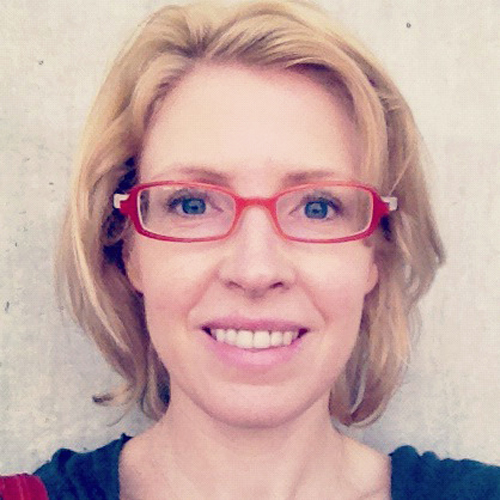 Sasha Pierce. Photo: Toni Hafkenscheid.
Sasha Pierce. Photo: Toni Hafkenscheid.
P.A: Your current geometric paintings are very detailed and intricate. Can you explain the process of constructing these works?
S.P: I have an unusual way of painting. I mix a number of oil paint colours on a palette and carefully place the paint in a small plastic bag at the corner, then I cut a small tip off the corner to squeeze the multi-coloured paint out. I apply a line of paint with a small repetitive gesture to create texture. I use a ruler to straighten the paint from a thin line to thinner line and ultimately to a vanishing point. I repeat this process onto the entire surface, using over 30 paint-filled bags at a time to achieve a variety of hues and tones.
P.A: The process seems rather labour intense. How long does it take to complete a piece?
S.P: Yes, the process is labour intensive. Each painting takes a month to two months to complete, depending on the complexity.
P.A: Do you have a draft pattern to work from? How do you decide on how it will look when finished?
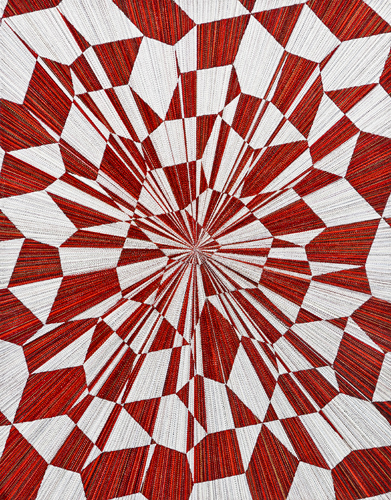 Sasha Pierce, Fire Agate, 2012, oil on linen, 23 x 18 inches
Sasha Pierce, Fire Agate, 2012, oil on linen, 23 x 18 inches
S.P: I use tessellations pattern to guide my compositions. Tesselations are the process of creating a two-dimensional plane using the repetition of a geometric shape with no overlaps and no gaps. For example the tessellation I appropriated for “Fire Agate” is the tilling of congruent pentagons that was discovered by Marjorie Rice in 1995 and whose work is installed on the floor of the Mathematical Association of America headquarters in Washington, D.C. I choose to work with certain tessellations because of the way the interlocking shapes combined to make a variety of new ones. The various shapes create an unstable or multi-focus that contrasts with the central point. Because of the different systems I use to create the work I don’t have a clear idea how the painting will look until it is finished.
P.A: Previously your works replicated textiles. Is there a connection?
S.P: I have been using the formal and abstract qualities of textiles as a reference point for my paintings starting with work I completed during my undergraduate degree at the University of Guelph. My early work was focused on mimetic representation such as a thick paint bas-relief of my personal sleeping bedding. Later I shifted away from representation towards abstraction. Currently the connection to textiles is conjured through my process where I use geometry and architecture as the source for my paintings.
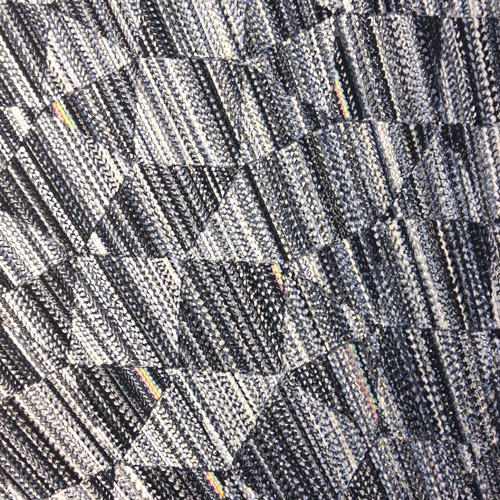 Sasha Pierce, White Diamond detail, 2012, oil on linen, 23 x 18 inches
Sasha Pierce, White Diamond detail, 2012, oil on linen, 23 x 18 inches
P.A: I understand you feel there is a tie with textiles and your family roots. Can you elaborate on this relationship?
S.P: Textiles not only serve a vital function to keep us warm they also non-verbally communicate the identity of an individual or group. I feel textiles connect me to my ancestors, family, and memories. My ancestors were working class people and my great grandmothers created beautiful quilts using worn out clothes. My grandfather used to fix my great grandmothers sewing machine and he has repaired and sold sewing machines for the past 70 years. My earliest memories include shopping for clothes with my mother and sister.
P.A: You have had some very successful exhibits in the Houston and Los Angeles. How you see the American contemporary art scene compared to Toronto? Is there a difference in attitudes?
S.P: I was only in Houston and Los Angeles for a short time for the openings, so it is difficult for me to discuss the differences in attitudes. I have been lucky because my experience with galleries has been very positive both in the US and Canada. Los Angeles does have a large art audience and that was great to experience.
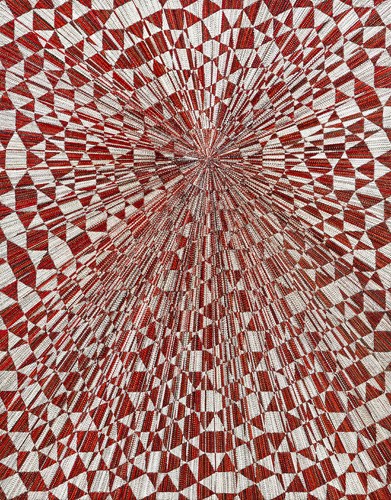 Sasha Pierce, Lake Superior Agate, 2012, oil on linen, 23 x 18 inches
Sasha Pierce, Lake Superior Agate, 2012, oil on linen, 23 x 18 inches
P.A: What lead to your exhibitions in the US?
S.P: I was asked to exhibit with Bryan Miller at CTRL Gallery in Houston a year after he saw my work at the 2008 NEXT Art Fair in Chicago through Kineko Ivic at Greener Pastures. Both Greener Pastures and CTRL Gallery are now closed.
Then in 2010 LA writer and curator Jan Tumlir curated my work in The Non-Identical Abstraction Engine group exhibition at ACME. The exhibition explored Robert Linsley’s New Models for abstraction fellowship at the University of Waterloo, 2004-2010. Then I had an opportunity to return to ACME for a solo show later that year.
P.A: When you were studying at Guelph and Waterloo were there any particular artists who influenced your art practice?
S.P: Yes I have been influenced by many artist including professors and my peers. I have been influence by abstract artists, which include Agnes Martin (American/Canadian, 1912-2004), Bridget Riley (British, 1931-) and Tomma Abts (Britsh/German,1967-). Perhaps in terms of influence it is more that these artists gave me the permission to go in the direction that I wanted to go.
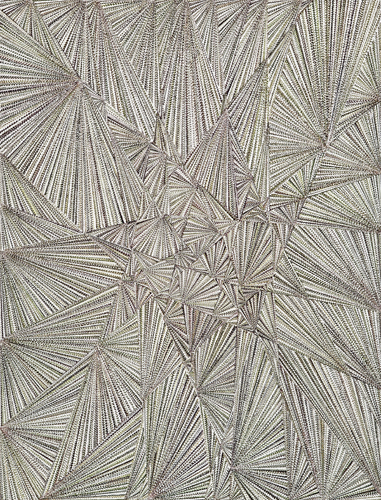 Sasha Pierce, Cycle, 2011, oil on linen, 21 x 16 inches
Sasha Pierce, Cycle, 2011, oil on linen, 21 x 16 inches
P.A: Is there any advice you would give to young painters struggling with their work?
S.P: Doubt can be a big challenge because art is rarely rational. I feel, staying connected to inspiration is really important as well as patience and perseverance. Running, cooking healthy food and having fun with friends and family can help enhance a creative lifestyle.
P.A: What is next for you in terms of upcoming exhibitions?
S.P: I will have work in Post, an upcoming group show at the University of Waterloo Art Gallery (UWAG), which is a post-grad, and Shantz internship survey curated by Ivan Jurakic. The exhibition opens September 13th and runs until October 27th, 2012. Visit www.uwag.uwaterloo.ca for more details.
